 W
WA curse is any expressed wish that some form of adversity or misfortune will befall or attach to one or more persons, a place, or an object. In particular, "curse" may refer to such a wish or pronouncement made effective by a supernatural or spiritual power, such as a god or gods, a spirit, or a natural force, or else as a kind of spell by magic or witchcraft; in the latter sense, a curse can also be called a hex or a jinx. In many belief systems, the curse itself is considered to have some causative force in the result. To reverse or eliminate a curse is sometimes called "removal" or "breaking", as the spell has to be dispelled, and is often requiring elaborate rituals or prayers.
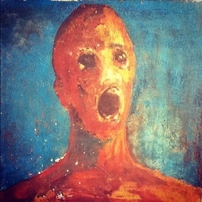 W
WThe Anguished Man is a painting created by an unknown artist and owned by Sean Robinson. According to Robinson, who claims to have inherited the painting from his grandmother, the artist who created the painting allegedly mixed his own blood into the paint and died by suicide soon after finishing the work. The painting has been characterized as being supposedly haunted. Robinson has uploaded video recordings of the painting to his YouTube channel.
 W
WAtuk is the name of an unfilmed American film screenplay, intended to be a film adaptation based upon the novel of 1963, The Incomparable Atuk, by Canadian author Mordecai Richler. It is essentially a fish out of water comedy of a proud, mighty Inuit hunter trying to adapt to life in the big city with satirical elements on racism, materialism, and popular culture.
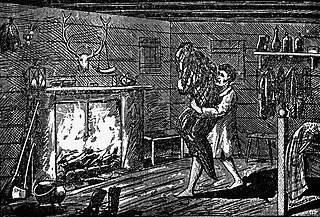 W
WThe Bell Witch or Bell Witch Haunting is a legend from Southern United States folklore, centered on the 19th-century Bell family of northwest Robertson County, Tennessee. Farmer John Bell Sr. resided with his family along the Red River in an area currently near the town of Adams. According to legend, from 1817-1821, his family and the local area came under attack by a mostly invisible entity that was able to speak, affect the physical environment, and shapeshift. Some accounts record the spirit also to have been clairvoyant and capable of crossing long distances with superhuman speed.
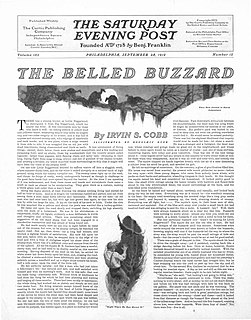 W
WThe belled buzzard is a fearsome critter in American folklore frequently cited as an omen of disaster by the sounding of its bell. The animal is otherwise depicted as an ordinary buzzard except with a bell affixed to it. The belled buzzard originated from actual accounts of turkey vultures being fastened with cow or sleigh bells. The belief that the belled buzzard was one continuous entity, and not multiple birds, was common, and the creature rose to prominence in the 1880s on through the turn of the twentieth century. Belled buzzard stories circulated principally throughout the southern United States, and it is the origin of the colloquialism "not enough sense to bell a buzzard."
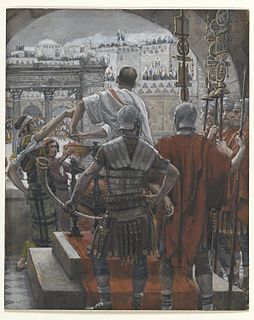 W
WThe blood curse refers to a New Testament passage from the Gospel of Matthew, which describes events taking place in Pilate's court before the crucifixion of Jesus and specifically the apparent willingness of the Jews to accept liability for Jesus' death.
 W
WThe Chained Oak is an oak tree, tied in chains, near to the village of Alton, Staffordshire, England. The tree, referred to as "The Old Oak", is the subject of a local legend involving the Earl of Shrewsbury and an old beggar woman. It is located on a public footpath to the left of the Chained Oak B&B.
 W
WThe Crying Boy is a mass-produced print of a painting by Italian painter Giovanni Bragolin. This was the pen-name of the painter Bruno Amarillo. It was widely distributed from the 1950s onwards.
 W
WThe curse of Cain and the mark of Cain are phrases that originated in the story of Adam and Eve in the Hebrew Bible. In the stories, if someone harmed Cain, the damage would come back sevenfold. Some interpretations view this as a physical mark, whereas other interpretations see the "mark" as a sign, and not as a physical mark on Cain himself. The King James Version of the Bible reads "set a mark upon Cain."
 W
WCarlisle is a border city and the county town of Cumbria as well as the administrative centre of the City of Carlisle district in North West England. Carlisle is located at the confluence of the rivers Eden, Caldew and Petteril, 10 miles (16 km) south of the Scottish border. Originally in the historic county of Cumberland, it is now the largest settlement in the county of Cumbria, and serves as the administrative centre for both Carlisle City Council and Cumbria County Council. At the time of the 2001 census, the population of Carlisle was 71,773, with 100,734 living in the wider city. Ten years later, at the 2011 census, the city's population had risen to 75,306, with 107,524 in the wider city.
 W
WThe curse of Ham occurs in the Book of Genesis, imposed by the patriarch Noah. It occurs in the context of Noah's drunkenness and is provoked by a shameful act perpetrated by Noah's son Ham, who "saw the nakedness of his father". The exact nature of Ham's transgression and the reason Noah cursed Canaan when Ham had sinned have been debated for over 2,000 years.
 W
WThe Curse of Muldoon was an alleged curse that supposedly prevented the Chicago Black Hawks of the National Hockey League from finishing in first place, either in their division or, from 1938 to 1967, in the single-division NHL. It may have been the first public example of the mainstream media publicizing a "curse" on a major-league sports franchise.
 W
WThe Curse of the Braganzas is a myth, referred to in several historical chronicles, concerning the House of Braganza, that ruled the Kingdom of Portugal (1640–1910), the United Kingdom of Portugal, Brazil and the Algarves (1815–1822) and the Empire of Brazil (1822–1889) and, therefore, all the Portuguese Overseas Empire.
 W
WThe Curse of Tippecanoe is the supposed pattern of deaths in office of presidents of the United States who won the elections in years that are evenly divisible by 20, since the 1840 election. Because of the timing of presidential elections, these are also those taking place in years ending with 0. The presidents fitting this description were William Henry Harrison, Abraham Lincoln (1860), James A. Garfield (1880), William McKinley (1900), Warren G. Harding (1920), Franklin D. Roosevelt (1940) and John F. Kennedy (1960).
 W
WThe cursing of the fig tree is an incident in the gospels, presented in Mark and Matthew as a miracle in connection with the entry into Jerusalem, and in Luke as a parable. The image is taken from the Old Testament symbol of the fig tree representing Israel, and the cursing of the fig tree in Mark and Matthew and the parallel story in Luke are thus symbolically directed against the Jews, who have not accepted Jesus as king.
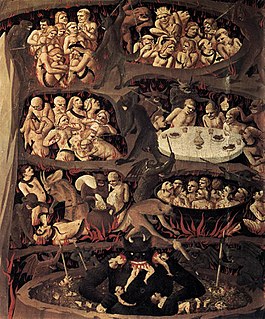 W
WDamnation is the concept of divine punishment and torment in an afterlife for actions that were committed on Earth. In Ancient Egyptian religious tradition, citizens would recite the 42 negative confessions of Maat as their heart was weighed against the feather of truth. If the citizen's heart was heavier than a feather they would be devoured by Ammit. Zoroastrianism developed an eschatological concept of a Last Judgment called Frashokereti where the dead will be raised and the righteous wade through a river of milk while the wicked will be burned in a river of molten metal. Abrahamic religions such as Christianity have similar concepts of believers facing judgement on a last day to determine if they will spend eternity in Gehenna or heaven for their sin. A damned human "in damnation" is said to be either in Hell, or living in a state wherein they are divorced from Heaven and/or in a state of disgrace from God's favor.
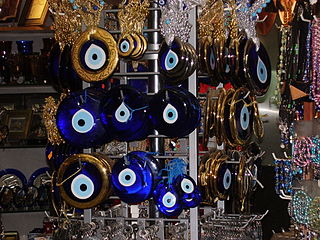 W
WThe evil eye is a superstitious curse or legend, believed to be cast by a malevolent glare, usually given to a person when one is unaware. It dates back at least to Greek classical antiquity, 6th century BCE where it appeared on Chalcidian drinking vessels, known as 'eye cups', as a type of apotropaic magic. Many cultures believe that receiving the evil eye will cause misfortune or injury, while others believe it to be a kind of supernatural force that casts or reflects a malevolent gaze back-upon those who wish harm upon others. Talismans or amulets created to protect against the evil eye are also frequently called "evil eyes". Older iterations of the symbol were often made of ceramic or clay, however, following the production of glass beads in the Mediterranean region in approximately 1500 BCE, evil eye beads were popularised with the Phoenicians, Persians, Greeks, Romans and Ottomans. Blue was likely used as it was relatively easy to create, however, modern evil eyes can be a range of colors.
 W
WA family curse or an ancestral curse, a generational curse, hereditary curse, is a curse, on a family. The belief in them crosses many religious beliefs. There is no reliable scientific evidence that curses exist.
 W
WThe Flying Dutchman is a legendary ghost ship which was said to never be able to make port, doomed to sail the oceans forever. The myth is likely to have originated from the 17th-century Golden Age of the Dutch East India Company (VOC) and Dutch maritime power. The oldest extant version of the legend has been dated to the late 18th century. According to the legend, if hailed by another ship, the crew of the Flying Dutchman was said to try to send messages to land, or to people long dead. Purported sightings in the 19th and 20th centuries claimed that the ship glowed with a ghostly light. In ocean lore, the sight of this phantom ship is a portent of doom.
 W
WThe Hands Resist Him is a painting created by artist Bill Stoneham in 1972. It depicts a young boy and a female doll standing in front of a glass paneled door, against which many hands are pressed. According to Stoneham, the boy is based on a photograph of himself at age five. The doorway is a representation of the dividing line between the waking world and the world of fantasy and impossibilities, while the doll is a guide that will escort the boy through it. The titular hands represent alternate lives or possibilities. The painting became the subject of an urban legend and a viral internet meme in February 2000 when it was posted for sale on eBay along with a description implying that it was haunted.
 W
WThe Hope Diamond is one of the most famous jewels in the world, with ownership records dating back almost four centuries. Its much-admired rare blue color is due to trace amounts of boron atoms. Weighing 45.52 carats, its exceptional size has revealed new findings about the formation of diamonds.
 W
WIn the Hindu epic Mahabharata, Kindama is a rishi who lived in the woods. Kindama is a very bashful person and his overriding feelings of modesty prevented him from having sex in the company of other humans. To satisfy his sexual desires, Kindama used his powers to turn himself and his wife into deer. Once he and his mate were having intercourse in the woods. King Pandu of Hastinapur, who had been hunting there, shot them mistaking them for deer, seriously injuring them. Enraged Kindama berated the king for having killed him before he had finished the act of copulation. Before dying, Kindama cursed Pandu that he would die the moment he engaged in intercourse with any woman.
 W
WThe Kosovo curse or Prince's curse, is according to legend, a curse said by Serbian Prince Lazar before the Battle of Kosovo. Lazar curses those Serbs who ignored his call for war against the Ottoman Empire. Constantine of Kostenets recorded that Lazar issued "invitation and threat" to Serbian states which is preserved in the Serbian epic poetry in the form of the curse.
 W
WKurdaitcha is a type of shaman amongst the Arrernte people, an Aboriginal group in Central Australia. The kurdaitcha may be brought in to punish a guilty party by death. The word may also relate to the ritual in which the death is willed by the kurdaitcha man, known also as bone-pointing. The word may also be used by Europeans to refer to the shoes worn by the Kurdaitcha, which are woven of feathers and human hair and treated with blood.
 W
WThe loathly lady, is a tale type commonly used in medieval literature, most famously in Geoffrey Chaucer's The Wife of Bath's Tale. The motif is that of a woman who appears unattractive but undergoes a transformation upon being approached by a man in spite of her unattractiveness, becoming extremely desirable. It is then revealed that her ugliness was the result of a curse which was broken by the hero's action.
 W
WMan Proposes, God Disposes is an 1864 oil-on-canvas painting by Edwin Landseer. The work was inspired by the search for Franklin's lost expedition which disappeared in the Arctic after 1845. The painting is in the collection of Royal Holloway, University of London, and is the subject of superstitious urban myth that the painting is haunted.
 W
WMatthew 5:44, the forty-fourth verse in the fifth chapter of the Gospel of Matthew in the New Testament, also found in Luke 6:27–36, is part of the Sermon on the Mount. This is the second verse of the final antithesis, that on the commandment to Love thy neighbour as thyself. Jesus has just stated that some had taught that one should "hate your enemies" and in this verse he rejects this view.
 W
WA nithing pole, sometimes normalized as nithstang or nidstang, was a pole used for cursing an enemy in Germanic pagan tradition.
 W
WÖtzi, also called the Iceman, is the natural mummy of a man who lived between 3400 and 3100 BCE, discovered in September 1991 in the Ötztal Alps on the border between Austria and Italy.
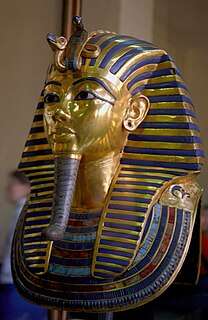 W
WThe curse of the pharaohs or the mummy's curse is a curse alleged to be cast upon anyone who disturbs the mummy of an ancient Egyptian, especially a pharaoh. This curse, which does not differentiate between thieves and archaeologists, is claimed to cause bad luck, illness, or death. Since the mid-20th century, many authors and documentaries have argued that the curse is 'real' in the sense of having scientifically explicable causes such as bacteria or radiation. However, the modern origins of Egyptian mummy curse tales, their development primarily in European cultures, the shift from magic to science to explain curses, and their changing uses—from condemning disturbance of the dead to entertaining horror film audiences—suggest that Egyptian curses are primarily a cultural, not exclusively scientific, phenomenon.
 W
WThe Vyne Ring or the Ring of Silvianus is a gold ring, dating probably from the 4th century AD, discovered in a ploughed field near Silchester, in Hampshire, England, in 1785. Originally the property of a British Roman called Silvianus, it was apparently stolen by a person named Senicianus, upon whom Silvianus called down a curse.
 W
WThe second-term curse is the perceived tendency of second terms of U.S. presidents to be less successful than their first terms.
 W
WThe "sweater curse" or "curse of the love sweater" is a term used by knitters to describe the belief that if a knitter gives a hand-knit sweater to a significant other, it will lead to the recipient breaking up with the knitter. In an alternative formulation, the relationship will end before the sweater is even completed. The belief is widely discussed in knitting publications, and some knitters claim to have experienced it. In a 2005 poll, 15% of active knitters said that they had experienced the sweater curse firsthand, and 41% considered it a possibility that should be taken seriously.
 W
WThe Tichborne Dole is a traditional English festival of charity which is held in the village of Tichborne, Hampshire, during the Feast of the Annunciation. The festival is centered on the handing out of donations of flour, which have been blessed by the local parish priest, from the front of Tichborne House.
 W
WTutankhamun, Egyptological pronunciation Tutankhamen, commonly referred to as King Tut, was an ancient Egyptian pharaoh who was the last of his royal family to rule during the end of the 18th Dynasty during the New Kingdom of Egyptian history. His father was the pharaoh Akhenaten, believed to be the mummy found in the tomb KV55. His mother is his father's sister, identified through DNA testing as an unknown mummy referred to as "The Younger Lady" who was found in KV35.
 W
WThe Wandering Jew is a mythical immortal man whose legend began to spread in Europe in the 13th century. In the original legend, a Jew who taunted Jesus on the way to the Crucifixion was then cursed to walk the Earth until the Second Coming. The exact nature of the wanderer's indiscretion varies in different versions of the tale, as do aspects of his character; sometimes he is said to be a shoemaker or other tradesman, while sometimes he is the doorman at the estate of Pontius Pilate.
 W
WThe winner's curse is a phenomenon that may occur in common value auctions, where all bidders have the same value for an item but receive different private signals about this value and wherein the winner is the bidder with the most optimistic evaluation of the asset and therefore will tend to overestimate and overpay. Accordingly, the winner will be "cursed" in one of two ways: either the winning bid will exceed the value of the auctioned asset making the winner worse off in absolute terms, or the value of the asset will be less than the bidder anticipated, so the bidder may garner a net gain but will be worse off than anticipated. However, an actual overpayment will generally occur only if the winner fails to account for the winner's curse when bidding.